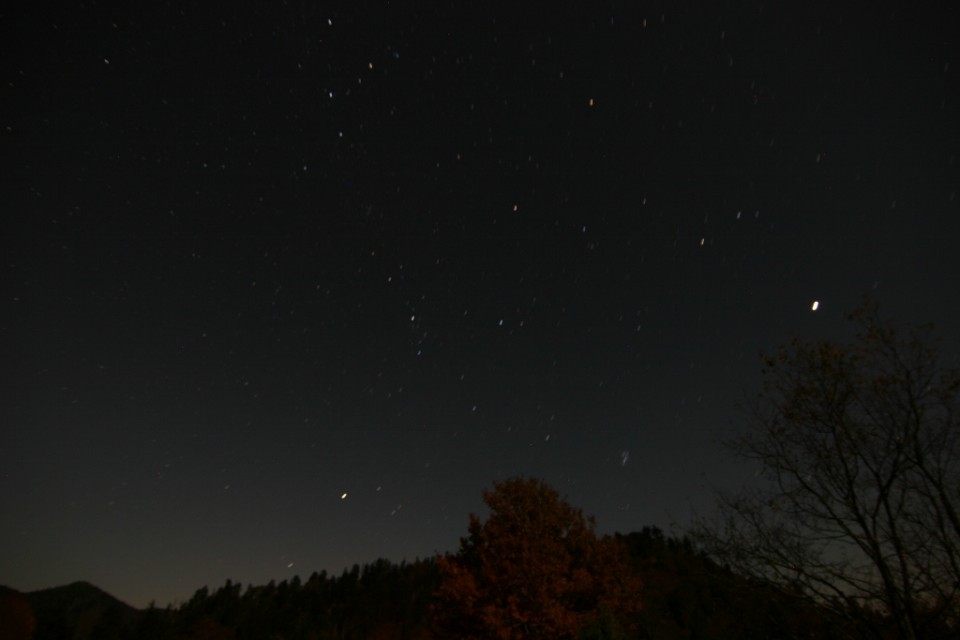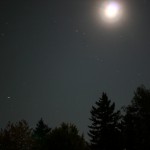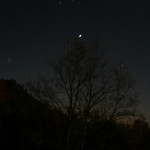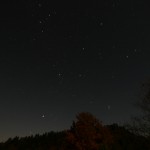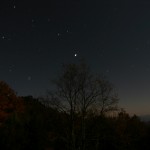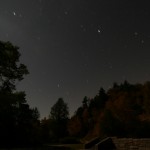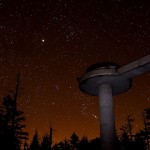The Great Smoky Mountains National Park is a very quiet place at night, which is good for all you stargazers out there. It’s a totally different world as most people leave, the cars seem fewer and far between and most of the animals have gone in for the night. Nothing to see, right? Wrong. In fact, you could argue that there is even more to see at night than during the day. Stargazing in the Smokies is a great way to get to know the natural elements of the Smoky Mountains minus all the daily visitors
The term “celestial wildlife” comes to mind when talking about stargazing in the Smoky Mountains. Stars that are usually hidden due to city lights are seen majestically undeterred. Orion’s belt seems to be accessorized by additional stars. Ursa Major and Ursa Minor come into clear view and their resemblance to a large bear is more distinct. From any of the observation points in the Smoky Mountains, or from any backcountry vantage point, the night sky opens up as you leave the vestiges of civilization and work your way towards the Smokies. Speaking of vantage points, Newfound Gap Trailhead, which doubles as a parking area for one of the most hiked portions of the Appalachian Trail, is a prime spot to stargaze in the Smokies.
Newfound Gap Trailhead is void of any street lights and there are no cities close enough to muddy up the sky at night. At night, the parking lot is usually vacant with the exception of a few cars and the passing cars won’t affect your night vision. Once you reach the trailhead, go to the furthest end of the parking lot, dim the lights and wait for your eyes to adjust to the darkness. Then you’ll slowly start to see some eye-popping sights in the night sky. This parking lot is 6,000 feet above sea level so you may want to pack a coat if you decide to stargaze in the early spring or fall. For example, if it’s 60 degrees in Pigeon Forge, then it will be at least 10 degrees cooler in the Smokies.
 The moon and its position in the night sky is another thing to keep in mind. The moon at its peak is ten times brighter in the Smoky Mountains than the stars. A full moon on top of the mountain is a spectacular sight to behold but if you’re planning on looking at stars keep the phase of the moon in mind. A new moon is the perfect time to see the most stars. Sans a full moon, your view of the stars will be unobstructed and your stargazing trip to the Great Smoky Mountains will be complete. If you want to see an amazing moonrise, then get to the summit early during a full moon and it will bright enough to read by.
The moon and its position in the night sky is another thing to keep in mind. The moon at its peak is ten times brighter in the Smoky Mountains than the stars. A full moon on top of the mountain is a spectacular sight to behold but if you’re planning on looking at stars keep the phase of the moon in mind. A new moon is the perfect time to see the most stars. Sans a full moon, your view of the stars will be unobstructed and your stargazing trip to the Great Smoky Mountains will be complete. If you want to see an amazing moonrise, then get to the summit early during a full moon and it will bright enough to read by.
Because of the lack of lights on the mountain it is possible to take pictures of this starry expanse. You will need to turn the flash off on your camera and you will have to use fairly long exposures. Long exposures (one and half to two minutes minimum) will produce star lines on the exposure. The Earth’s constant movement in relation to the unmovable positions of the stars causes the star lines. This is what you want. Lots of light into the camera and giving the camera enough time to absorb the light you are letting it will make the outline of the trees hazy and the stars will be small streaks in the sky. You’ll need to use a tripod to eliminate movement of the camera.
If you are looking for an after-hours opportunity for your family to enjoy something they may not get to see anywhere else, get out of the cabin or hotel room, pack up the cool weather gear and head to the top of the Smokies, or a place like Cades Cove. Put a sleeping bag on the hood of your car, lean back and enjoy the view. Instead of looking at the gorgeous mountains below the heavens, turn your eyes upward and look at the stars.
